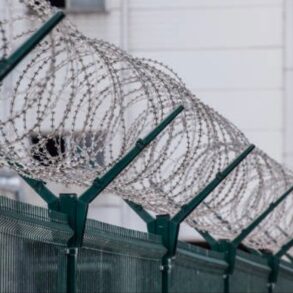This is The Marshall Project’s Closing Argument newsletter, a weekly deep dive into a key criminal justice issue. Want this delivered to your inbox? Subscribe to future newsletters.
During his first month in office, President Donald Trump has made moves to expand the United States’ already gargantuan carceral system. The Trump administration’s goals, from mass deportation to harsher punishments for some crimes, are reliant on the federal government having access to more prison and jail cells. Without that carceral infrastructure, it will be difficult, if not impossible, to enact his promises on immigration and crime and punishment.
During his presidential campaign, Trump vowed to deport a historic number of people. And while Trump’s focus so far has been on undocumented immigrants, his criminalization efforts extend to U.S. citizens too. Attorney General Pam Bondi has issued memos that could encourage federal prosecutors to seek harsher sentences in many circumstances.
Detaining and incarcerating more people necessitates more places to put them, and the administration is already hitting limits. Last week, space inside Immigration and Customs Enforcement detention facilities reached 109% capacity and the agency was forced to release some people.
This lack of space is one of the major barriers to ramping up deportations, and ICE is limited by its budget. But Trump is now considering tapping into defense funds. Those funds “would allow civilian-run companies to quickly and rapidly expand temporary detention facilities,” such as tents, according to NBC News.
ICE has also begun sending some detainees to the federal Bureau of Prisons. But the BOP was already in crisis before Trump took office, as described by the Justice Department’s Office of the Inspector General. The low ratio of staff to incarcerated people has left the BOP struggling to provide security and basic services to the people imprisoned in its facilities, putting their safety — and that of employees — at risk.
Private prison companies are celebrating the Trump administration’s need for more cells. In a press release and earnings call earlier this week, CoreCivic’s CEO told investors that this was one of the most exciting periods of his career, and it may lead to the “most significant growth in our company’s history.” The company, which has contracts to detain people for ICE, said they expect the immigration agency to massively increase the number of people it will hold behind bars.
Company officials believe they may also see growth in the Bureau of Prisons, according to The Arizona Republic. One of Trump’s first actions as president was to allow the BOP to contract with private prison companies again, after then-President Joe Biden canceled BOP private prison contracts. (The use of private detention for immigration has continued under both Democratic and Republican administrations, with Biden arguably laying the foundation for much of the infrastructure Trump’s mass deportation efforts will rely on.)
Yet another sign of a private prison infrastructure expansion is a report that the Trump administration is preparing to restart family immigrant detention, including incarcerating families with young children, and is expected to ask companies to bid for contracts, according to NBC News.
While much attention has been given to private companies, local jails are the most common type of detention facility that ICE uses, according to a report from Vera, an advocacy organization working to end mass incarceration. The Biden administration already had agreements with local jails to house ICE detainees. But Trump’s border czar, Tom Homan, has been encouraging sheriffs to make even more space available for immigrant detention. At the National Sheriffs’ Association Winter Conference earlier this month, he told sheriffs: “We need your bed space.”
Homan promised to make it easier for local jails to incarcerate people for ICE by lowering detention standards and limiting the number of federal inspections. He said he hoped to eliminate federal rules and instead defer to state-level standards. “If that’s good enough for a U.S. citizen in your county, it’s good enough for an illegal immigrant detained for us,” Homan said.
Local officials are often incentivized to provide jail space to ICE because of reimbursement rates. Sheriffs and politicians have talked about how ICE payments produce revenue and help cover city services. Other sheriffs have said they will need more money to do what the federal government is asking counties to do. Some local politicians are offering space because of ideological support for Trump’s goals. An Arizona state senator said he plans to introduce a bill allowing ICE to use two empty state prisons for just a dollar a year. And Texas Gov. Greg Abbott has offered Trump the use of 4,000 state prison cells at no cost.
Other state politicians have resisted cooperation with ICE. A law in Illinois prohibits local sheriffs from renting jail space for immigrant detention. Trump is now suing the state over the law.
The president’s search for more prison and jail cells for imprisoning both citizens and undocumented immigrants extends beyond U.S. borders.
Earlier this month, Trump said he was considering El Salvador’s offer to incarcerate both deported immigrants from any nationality and U.S. citizens in its infamous prisons. Trump said the Central American country offered to detain people for a “small fee.” He also said, “We could make deals where we’d get these animals out of our country.” Experts say it is not legal to deport a U.S. citizen, and while it is, in some cases, legal to deport a non-citizen to a third country, it’s a complicated process.
Trump has also indicated that he wants to house more than 30,000 migrants at Guantánamo Bay in Cuba. The naval base has a long history of allegations of human rights abuses, and lawyers have raised concerns that immigrants are being sent into a “legal black hole,” according to The Washington Post. Around three dozen people have already been sent to Guantánamo, but there are major hurdles to reaching the numbers Trump has projected. The most the facility has ever held is about 800 people, according to NPR, and housing more would be incredibly expensive. In addition, the administration has already hit legal hurdles — earlier this week a judge in New Mexico blocked, for now, the administration’s effort to send three Venezuelan men to Guantánamo.
Many have speculated that Trump’s sending people to Guantánamo, like many of his immigration efforts, is an attempt to create a massive spectacle intended to project power and instill fear.
But despite the significant legal and practical barriers, the Trump administration’s numerous efforts to find more jail and prison cells indicate a clear desire to build a larger carceral system.
Trump has styled himself as a “law and order” president and is using that frame in his efforts at expanded incarceration. But despite his wide-ranging moves to increase prison and jail space, he has been selective in who should be imprisoned or punished for illegal behavior.
Trump himself has been convicted of numerous felonies. On the first day of his administration, he granted clemency to 1,500 Jan. 6 defendants. And earlier this week, the Justice Department ordered prosecutors to drop corruption charges against New York City Mayor Eric Adams, who was accused in September of accepting bribes and free or discounted travel from people trying to influence him. Multiple department employees have resigned over the order. A Justice Department memo, obtained by The Associated Press, said the charges should be dropped because they were interfering with Adams’ “ability to devote full attention and resources to the illegal immigration and violent crime.”
This post was originally published on this site be sure to check out more of their content.








